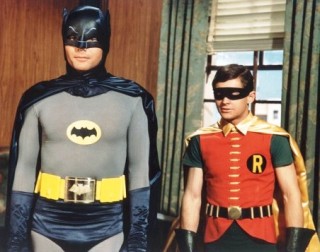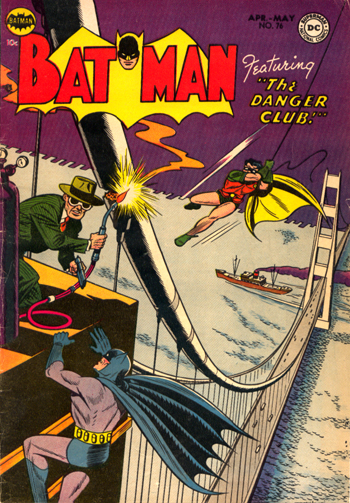|
Page A4 The Joan De Arc Crusader / Saturday, July 7, 2007 Front Page A1 / Editorials A2 / Nostalgia A3 / Crossword A5
The comic book trade on Joan De Arc
By J. Bueker From a distance of forty odd years, it is difficult to fully appreciate the overwhelming influence wrought by the emergence of the Batman television program back in January of 1966. The entire nation, not to mention our entire neighborhood, was quickly enveloped by the ensuing “Bat Craze,” a remarkable phenomenon engendered by a show that was, in hindsight, exceptionally silly and campy even by the standards of 1960s television. We kids on Joan De Arc however, like most American youngsters, quickly came to regard the show as an exceedingly crucial development in the history of western culture. Suddenly every bike on the street sported a Bat sticker, Adam West and Burt Ward were featured on the cover of Mad magazine, and “Powie!” and “Kazap!” became part and parcel of our daily vernacular. “Batman” was soon added to an already crowded field of TV-inspired playtime activities that included “Combat!,” “The Man from UNCLE,” and “Lost in Space.” The show was on early enough in the summer evenings that we actually had time afterwards to rush outside and fight crime for a good hour or so before darkness fell over Surrey Heights. To add a touch of realism to our Bat play, my dear mother cleverly devised the idea of creating bat cowls from old sweaters we had stored in the cedar chests in our garage, and soon I was the envy of the street for my improvised Batman get-up. The usual Joan De Arc kid cast and crew performed with their typical brilliance in our Batman play, particularly yours truly in the role of the Dark Knight. Yet I seem to remember better still some of the “guest stars” who helped make the activity noteworthy with their brief appearances in the performance. Our younger cousin Jennifer Hilbert from Michigan for instance was positively sublime in the role of Robin the Boy Wonder during her infrequent visits to Joan De Arc Avenue. Every gimmick in the show was an inspiration, particularly the opening sequence of each episode wherein the Dynamic Duo, relaxing in their mansion at Wayne Manor, answer their suddenly beeping Batphone, receive an urgent request for help from Commissioner Gordon, and then magically change into their crime fighting costumes as they slide down their Batpoles to the Batcave. I created our very own Batpole control device by simply drawing one with a pencil and piece of paper, and then taping the object behind one of the antique pistol pictures that graced the wall of my and brother Charles’s bedroom at 3219 (the Batpole control device on the show was actually a button concealed within a bust of Shakespeare on the desk in Bruce Wayne’s study). When the time came to slide down the poles and change into our superhero costumes, we would access the switch in its secret location behind the picture on the wall and then sprint to the closet at the other end of the room, which we had designated as the location of our imaginary Batpoles. That “Batpole control” piece of paper remained taped to the back of the pistol picture in our bedroom for quite a few years after our Batman-playing days had come to an end. Naturally, the popularity of the Batman show accelerated my already burgeoning interest in the comic book arts. Although Marvel comics were steadily increasing in popularity at this time, I was always exclusively interested in the DC universe of Batman, Superman, Flash, Green Lantern, et al. Spiderman and the Fantastic Four were only of passing interest, and only then because of their admittedly very cool cartoon shows on Saturday morning TV. Such latecomer wannabes however could not and still cannot hold the proverbial candle, in my view, to the Man of Steel and Caped Crusader. Tell me I’m wrong. The neighborhood Circle K at Cactus and 35th Ave. was my primary source for comic books in those days, and I was allowed to purchase precisely one each month, this despite my father’s stern misgivings regarding such literature. Something in his strict Catholic upbringing was apparently adverse to the depiction of beings who displayed powers that even Jesus did not possess. I also occasionally purchased comics at the Chris-Town Walgreens, the Westown T.G.&Y., and several other now obscure locations . One day in the summer of 1966, while I was visiting grandparents Lois and Howard, my Aunt Sandy pleasantly surprised me with the latest copy of Batman when she returned from a trip to the neighborhood U-Tote-M store, a particularly cool issue with a cover featuring the Joker no less. However, my most interesting comic book acquisitions came as a result of trades with fellow comics aficionados. At some juncture during this period, my infatuation with comic books somehow caught the attention of Mrs. Sara Dusenberry. The Dusenberrys lived down the street at 3202, an interesting family with three children: Kelly, a year older than myself; Tony, a year younger than I; and Susie, a few years younger still. I remember very little about Mr. Dusenberry, who remained aloof, and I never got to know Susie much due to her tender age, but Sara, Kelly, and Tony all still reside in my fading memory to a significant extent. Kelly
Dusenberry was an excellent athlete and tough as nails. He was highly
competitive, remarkably gregarious, and notably protective of his younger
siblings. Tony was less athletic and more cerebral in nature than his brother,
and also something of a card. When Sahuaro School amended its dress code to
allow girls to wear pants in the late ‘60s, Tony impulsively protested the new
policy by wearing a dress to school the next day. I’m not kidding here. The kid
had guts. In any event, I was summoned to the Dusenberry home by Mrs. D. one fine Saturday in early 1967 to view her most excellent collection of Golden Age comics from the late ‘40s and ‘50s. The woman had avidly collected comic books as a young girl, amassing at length a most impressive assortment of specimens, mostly of the DC variety that I prized so very highly. Her comic books were neatly stacked in a large cardboard box that she kept in a closet of one of the bedrooms at the Dusenberry home. I was tantalizingly permitted to view but the first few comics on the very top of the pile during this initial visit, before the box was summarily closed up and returned to its designated location of safekeeping. My audience at the Dusenberry home that day was then ended, and I was sent on my way. I lay awake for nights speculating about what comic book treasures might reside in that magical cardboard box in the Dusenberry’s closet. As it turned out, Mrs. Dusenberry had a proposition for me. She confided that one of her greatest pleasures in collecting comics as a kid was the custom of trading the books that she was finished reading with her friends, thereby gaining fresh reading material at no further monetary expense. Indeed, a significant number of the comics in her priceless collection were procured in this very manner. And now, I was her friend! I naturally found this proposal eminently agreeable, particularly since the comics in my collection were all of very recent vintage and had cost me but twelve cents apiece, whilst Mrs. Dusenberry’s books were wonderfully old and relatively valuable. Mrs. D. found this glaring incongruity to be of no importance, and we proceeded to negotiate our first trade: In exchange for my latest brand new copy of Batman, I received a copy of Batman #76, which appeared in 1953. The beautifully preserved issue featured a superb Bob Kane cover depicting Batman clinging to the edge of a bridge being sabotaged by some bad guys while Robin swings valiantly into the picture on a Bat rope. The dizzying perspective of the image was brilliantly rendered and nearly sufficient to inspire a sense of vertigo. The featured story, “The Danger Club,” was a ‘50s Batman classic. This was an absolute treasure, even by 1960s standards. I could hardly believe my own good fortune. Back at 3219, the comic book trading with Mrs. Dusenberry evoked a somewhat mixed reaction. The general feeling was that she was being overly generous with me and was not being fairly compensated for the old comics of which she was letting go. I completely agreed with this thoughtful analysis, but what of it? All that mattered were those beautiful old comic books in the magical cardboard box in the Dusenberry’s bedroom closet. Let’s get that clue we always wanted, Mom and Dad. Mrs. D. and I proceeded to negotiate several more swaps in the ensuing months. At one point I found and clung to a very early issue of Wonder Woman from the Dusenberry comic box, and talked a reluctant Mrs. D into parting with it. If I had somehow managed to hang onto and actually preserve the comics I received in my trades with Mrs. D., their combined value would surely amount to a small fortune today. Of course, I did not. Sara Dusenberry remained inexplicably quite satisfied with our comic book exchanges, in spite of the fact that she could have easily obtained the latest copies of Batman and Superman herself at Circle K for a mere twelve cents each, as I had. Her pleasure in the transactions arose instead from the opportunity to relive an exceptionally pleasant childhood memory, and in equal measure from a chance to share the comic books that she grew up loving with the next generation of comics fans. The consensus at the time was that she was being a little eccentric or perhaps even a bit unbalanced. Of course, it was nothing of the kind. She knew exactly what she was doing. And it was a beautiful thing. _______________________________________________________________________________________________________________________JDA
|


